|
Motorcycle News - Chrurch of MO: 1999 600cc Supersport Shootout
https://ift.tt/2LczGzr 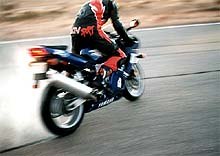 In those days, the rate of publication wasn’t anything like it is today, and so Plummer and Roland Sands and the other three wise men were able to spend not only days at Willow Springs, but even more time at SoCal’s finest dragstrips, wearing out clutches and making passes in an apparently tireless effort to name 600 numero uno – at a time when that class was hugely important. Suzuki, Honda, Yamaha and Kawasaki all still produce great 600 supersport bikes, but it’s not like it was 19 years ago. 1999 600cc Supersport ShootoutHead-On Collision
By Staff Feb. 23, 1999
Photography by Bruce Kusada
LOS ANGELES February 23, 1999 The hype has been intense: At the end of ’98, pervasive rumors claimed that Yamaha was developing a 600 supersport counterpart to their ground-breaking YZF-R1. Honda, it was said, was tooling up a fuel-injected replacement to the F3. Suzuki? Nothing new here, they just kicked butt on the race track, taking home the coveted AMA 600cc Supersport Championship in 1998 on their supposedly out-dated GSX-R600. Meanwhile, Kawasaki redesigned the ZX-6R, melding both track performance with street-going comfort, offering a combination of light weight, comfort and performance that proved so popular in Great Britain that for the first time in years the ZX-6R outsold Honda’s CBR600F3. Parity in the 600 class, it seems, had been achieved. Pete Rozelle wept from his luxury box in the sky. Some of the rhetoric proved to be true: Both Honda and Yamaha developed two all-new 600cc supersports: The still-carbureted but significantly refined CBR600F4 and the R1’s close cousin, Yamaha’s YZF-R6, respectively.
Back to the real world, early 1999 to be exact. You’ve impatiently waited for the new machines to come out, and now it’s time to plunk down some hard-earned money. So you want to know the skinny, right? Well, to aide in your quest, Motorcycle Online enlisted the help of reigning AMA Pro Thunder and 250 Grand Prix Champions Paul Harrell and Roland Sands to help us out in our 1999 600 shootout.
We chose to test the motorcycles using stock tires since many of our readers will use them until they are worn out and because changing tires can significantly change the characteristics of a motorcycle. Not that it mattered much, because the tires are very similar — the Honda, Yamaha and Suzuki are shod with DunlopD207’s street tires and the Kawasaki comes with BridgestoneBT56s. The only drawback in using stock tires was that track and drag strip times would suffer — surprisingly, we struggled more at the drag strip with the relatively slick stock tires than at the race track — otherwise using stock tires didn’t favor one bike over another. Each bike’s performance stood on factors not related to tire selection. Still, for those of you who are fit to be tied that we didn’t swap tires, flame us now. The most anticipated bike heading into the shootout had to be Yamaha’s YZF-R6, a motorcycle seemingly designed to elicit over-the-top superlatives from the motorcycle press. We rode the CBR600F4 at the Las Vegas Speedway and came away impressed with it’s superb balance. We looked forward to putting more miles on the ZX-6R as it’d been months since we rode one. It had also been a while since we rode the GSX-R600, two years in fact, back in our 1997 test, and we were interested in seeing how it faired against the new generation 600s on the Streets of Willow Springs, at the Carlsbad Raceway Drag Strip and highways of greater Los Angeles. Anyhow, enough of the bollocks, let’s get on with the test. 4: 1999 Suzuki GSX-R600
The oldest platform in the test, the Suzuki GSX-R600 has been tweaked throughout its three-year lifespan. In 1998 it received a larger airbox, revised exhaust system, different cam timing and reshaped ports to improve power across the powerband, and in 1999 Suzuki fitted the Gixxer with revised carburetor intake funnels, different jetting and a new igniter box for improved high rpm power. Peak power was improved: The GSX-R600 made 91.9 bhp at 10500 rpm and 45.1 ft-lbs of torque at 9500. That’s a decent jump over our 1997 test model that posted 88.7 bhp at 12,000 rpm and 43.4 ft-lbs at 10,000 rpm.
“Mid-range power also improved, and next to the F4 the GSX-R made the second most amount of torque.” The driveline lash that was so prominent on our 1997 test bike wasn’t noticed in this year’s model, but the riders complained of a flat spot around 10,000 rpm. We noticed carburetion difficulties on the 1997 GSX-R600 and we suspect that Suzuki still hasn’t sorted out this problem.
“It doesn’t really feel like a flat spot,” quipped Editor Plummer after drag strip testing, “but rather, it seems that either the carburetor needles are wrong or the throttle slides are rising at the wrong rate, either too slow or too fast, but in any event the power feels flat when you’re on the gas and shift gears at redline — there’s a highly noticeable lag in the power. In a sense, that’s good news, and jetting is easily correctable, while some strange cam/exhaust pipe problem isn’t.” The Suzuki made the least amount of peak horsepower, a factor that might have helped produce the slowest times at the drag strip — 11.149 seconds for the quarter-mile at 124.84 miles per hour. However, we believe that imprecise carburetor settings were the most likely culprit, as Editor Plummer — who does the drag strip testing — felt the Suzuki “would have hauled ass” on the drag strip if the carburetion problems were solved. In addition, the GSX-R600 was our least favorite street bike in this test, with many testers complaining of inordinate amounts of vibration, especially at higher rpms. The uncompromising riding position on the GSX-R didn’t win a lot of positive feedback and the bike never felt quite right unless ridden at a ten-tenths pace. “Suzuki pays more to club racers than anyone else in America.” Still, the brakes were good and the GSX-R600 might have the best stock chassis set-up in the entire test, although the shake and rattle lends to a perception of a less-than-finished motorcycle. Yet straight out of the box the Suzuki was perhaps the best race-ready motorcycle. Editor Plummer recorded his fastest lap times at the Streets of Willow Springs on the GSX-R (the fastest GSX-R time was Roland Sands at 1:15.02, Plummer was about a second behind) and it wasn’t until the suspension set-up began to be significantly adjusted that the racers’ lap times on the other three bikes began to pull away from the GSX-R600. “Roland and Paul started going much, much faster on the other bikes in the afternoon,” says Plummer, “but I never could get a confident feel from any of them, especially not in the front end — no street bike seems to feel as planted and secure as a good old GSX-R. While pros have the ability to go beyond their immediate impressions, for the rest of us, it’s hard or impossible to go fast on a bike that doesn’t feel planted. If I were going club racing, the Gixxer would be my choice, for sure.” Also in it’s favor, the Suzuki GSX-R600 has been around for a few years and there is a host aftermarket parts available for racers, not to mention the Suzuki Cup — at over a million dollars, Suzuki pays more to club racers than anyone else in America. 3: 1999 Kawasaki ZX-6R
Last year something rare happened over in Great Britain: For the first time in years the top selling 501 to 700cc class motorcycle was not a Honda, it was the Kawasaki ZX-6R. Aiming at the CBR600F3, the ZX-6R offered light weight, high performance and excellent handling characteristics along with improved aerodynamics, weather and wind protection, and relaxed ergonomics for a more comfortable street ride. The design worked, and Honda was forced to play catch up. In 1997, the ZX-6R placed last in our comparison. Vague front-end feedback along with low-profile stock Bridgestone tires resulted in a front end that “pushed” and “tucked” in corners. Even with race-compound tires the vague feedback on the 1997 ZX-6R continued and the lack of front-end feel was responsible for relegating the old 6R to last place. The 1997 ZX-6R had very narrow triple clamps that didn’t give much turning leverage. Kawasakiengineers addressed this by widening the handlebars, which also made the ZX-6R more comfortable, even though we thought the old ZX-6R was not an uncomfortable motorcycle. Kawasaki also stiffened the chassis and improved the suspension. As a result handling improved all around. At 445 pounds with a full tank of gas, the new generation ZX-6R is also about 18 pounds lighter than its predecessor, but is still the heaviest motorcycle in the test.
Throttle response on the ZX-6R was excellent, so was the positive-feeling gearbox and strong clutch (try as we might we couldn’t fry the clutch at the strip). The linear power delivery and higher-profile stock Bridgestone BT56 tires helped the ZX-6R post the fastest times in the quarter mile. With peak power outputs of 94 bhp at 12,750 rpm and 44.2 ft-lbs at 10,500 rpm the 6R ripped off a 10.937 second quarter mile at 127.41 miles per hour at the slower, slicker, sea-level Carlsbad Raceway (the 1997 ZX-6R posted a 10.79 quarter-mile at the LACR, a faster track at higher elevations that also posts very generous corrected times, usually by about three or four tenths of a second). “Overall we thought the Kawasaki was an excellent street bike…” Stoplight to stoplight Kawasaki intends to be the fastest, and with the ZX-6R they’re living up to their promise: “The Kawasaki rocks!” barked an elated Plummer after ripping off a 1.7-second 60-foot time and a high 10-second quarter mile. “It’s the only bike with precise throttle response and inherent traction off the line — if you want to smoke your pals at every street light, you’ll be hard-pressed to find any bike, big or small, that’ll run with the 6R from zero to 60.”
A comfortable, easy-to-ride street bike with a great engine, smooth throttle response and wide powerband that handled well on the street, the ZX-6R lagged behind the Honda and the Yamaha at the track. It’s at least 10 pounds heavier than the competition, feeling slow entering corners and not reacting well to mid-corner line changes. The six-piston caliper brakes — which are the same excellent Tokico calipers used on the GSX-R and the Team MO race bikes — didn’t have the same initial bite as the others, so consider changing brake pads if you own one. The ZX-6R’s fastest lap at the Streets of Willow Springs was Roland Sands’ 1:14.31, faster than his best GSX-R time but almost a full second slower than the fastest times recorded by the CBR600F4 and the YZF-R6. Still, the new ZX-6R is an enormous improvement over the old ’97 model. Overall we thought the Kawasaki was an excellent street bike — two staff members gave it second place votes — with a wonderful motor but its size kept it from overtaking the lighter, more agile Yamaha and Honda. The post Chrurch of MO: 1999 600cc Supersport Shootout appeared first on Motorcycle.com. Motorcycles via Motorcycle.comMotorcycle.com https://ift.tt/Xzx9iy May 20, 2018 at 12:11PM Leave a Reply. |
�
Categories
All
Archives
November 2020
|


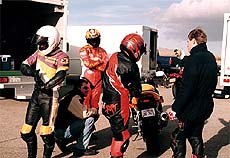 MO Editor Brent Plummer, AMA Pro Thunder and 250 Grand Prix Champions Paul Harrell &
MO Editor Brent Plummer, AMA Pro Thunder and 250 Grand Prix Champions Paul Harrell & 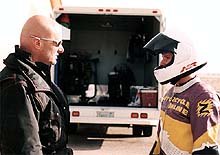 Managing Editor Mark Hammond and Plummer decide who will be to blame for the missing van door.
Managing Editor Mark Hammond and Plummer decide who will be to blame for the missing van door.
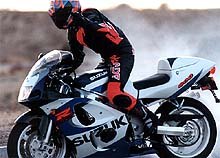

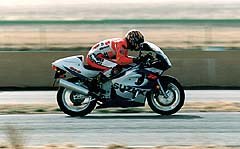
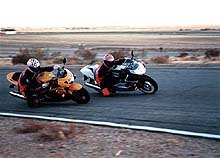
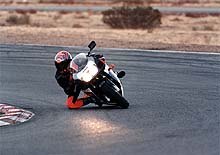
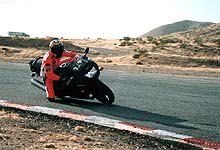
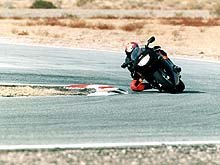
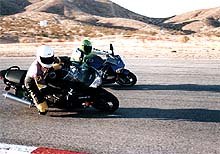
 RSS Feed
RSS Feed

5/20/2018
0 Comments